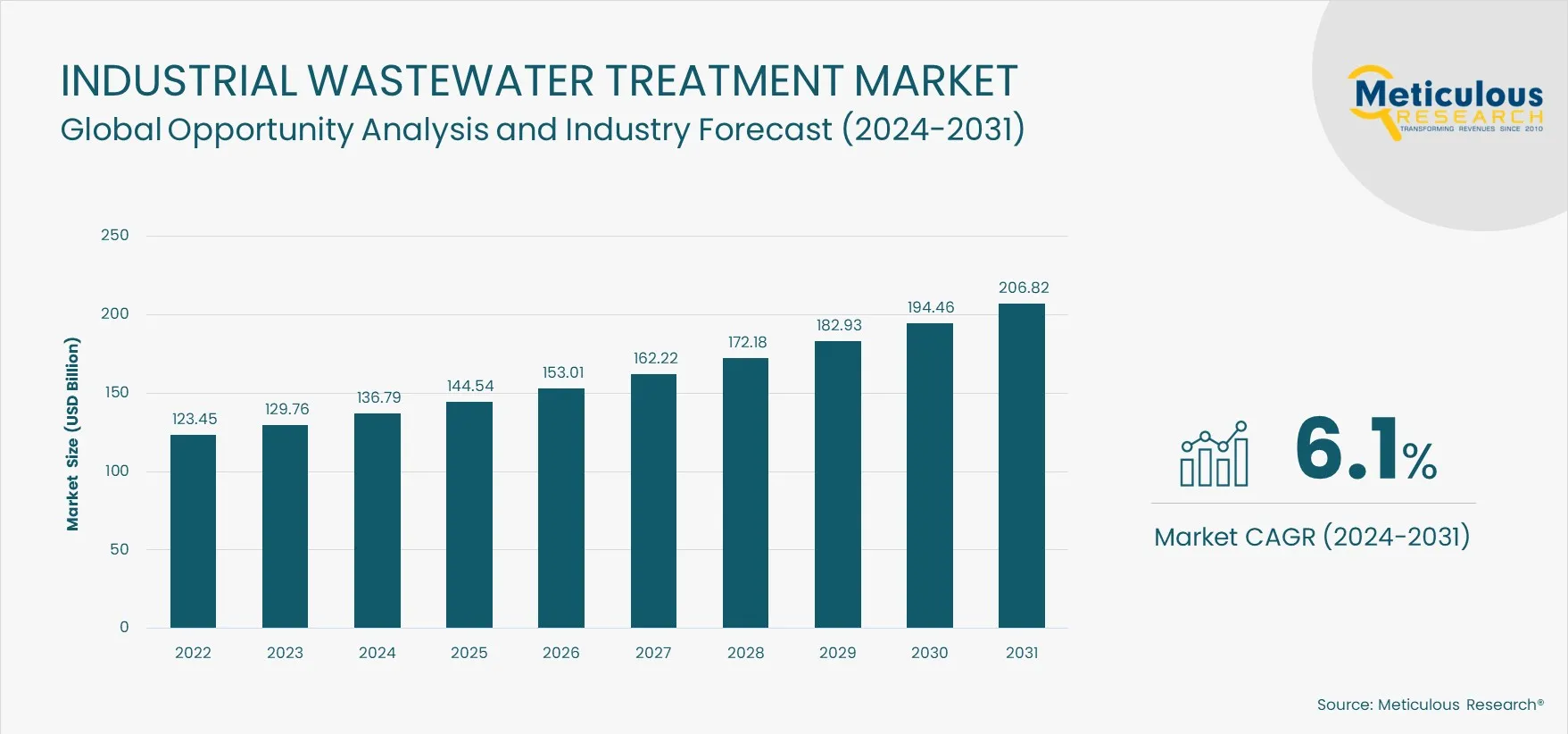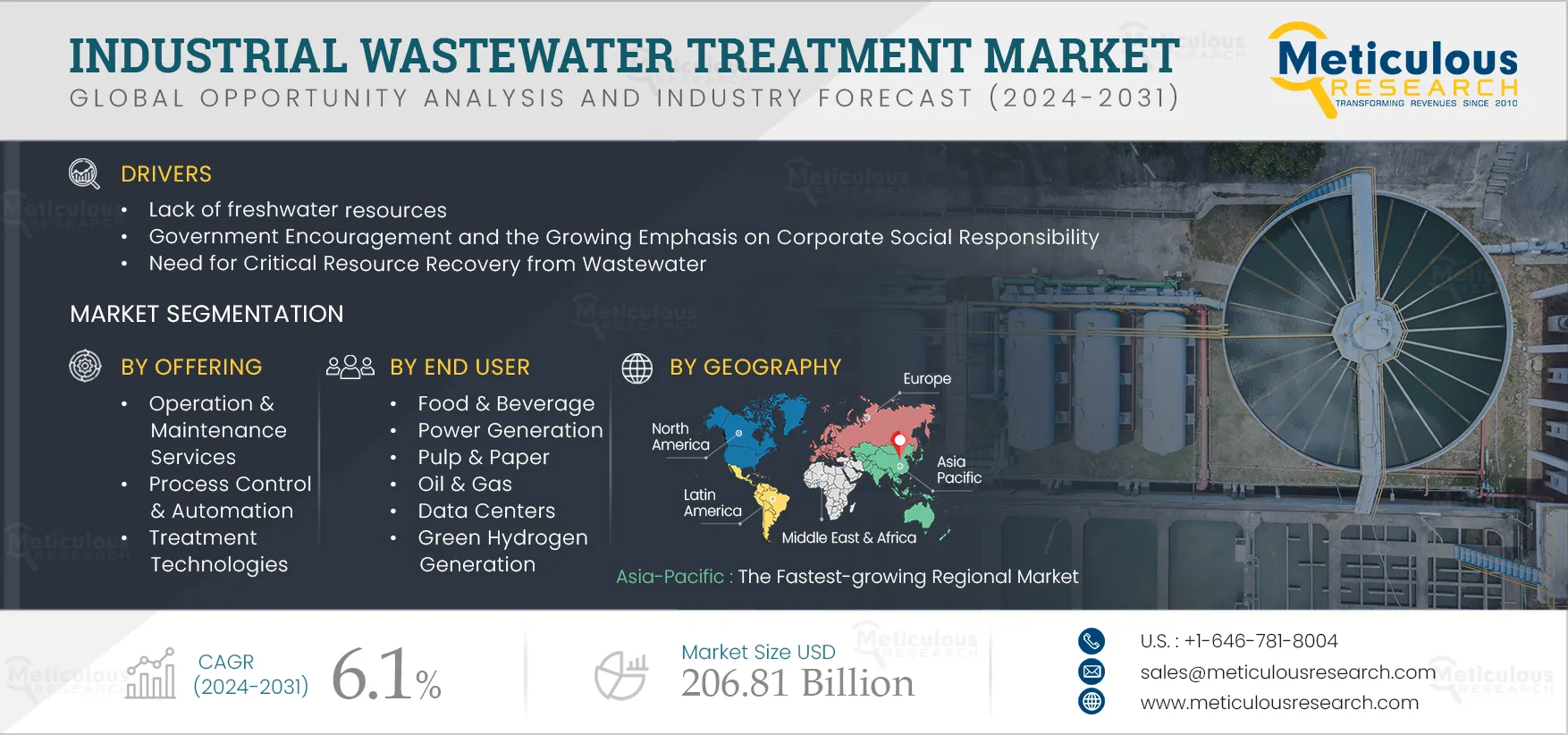The Industrial Wastewater Treatment Market is expected to reach $206.81 billion by 2031, at a CAGR of 6.1%during the forecast period. The growth of this market is driven by rapid population growth, urbanization, stringent water treatment regulations, the lack of freshwater resources, and the surge in waterborne diseases. However, high installation, maintenance, and operating costs restrain the growth of this market. The growing demand for energy-efficient and advanced water treatment technologies is expected to create market growth opportunities. However, the rise in energy consumption and expenses due to excess sludge production is a major challenge for the players operating in the industrial wastewater treatment market.
Here are the top 10 companies operating in the Industrial Wastewater Treatment Market
Suez Environnement S.A. (France)
Incorporated in 2000 and headquartered in Paris, France, Suez Environnement is engaged in providing water management, recycling and waste recovery, water treatment, and consulting services. The company operates in four business segments, namely, Water, Recycling and Recovery, ETS, and Other. The company offers water distribution and treatment services to individuals, local authorities, and industrial clients; waste collection and treatment services which include collection, sorting, recycling, composting, energy recovery, and landfilling for non-hazardous and hazardous waste to local authorities and industrial clients; and water, waste, and engineering services.
The company is engaged in the water management business that covers the collection & distribution of water, production of drinking water, wastewater treatment and reuse, management of the water cycle in the industry, public-private water partnerships, and water regulations.
The company focuses on collecting and logistics, sorting and dismantling, recovery and treatment, sanitation, maintenance and cleaning, decontamination of sites and soils, delegated waste management, and waste regulations in the recycling and recovery business.
The company has a geographical presence across Europe, North America, Asia-Pacific, Latin America, and the Middle East & Africa. As of 2020, the company had a headcount of 90,000 employees worldwide.
Veolia Environnement S.A. (France)
Founded in 1853 and headquartered in Paris, France, Veolia is engaged in providing several environmental services worldwide. The company operates in three business segments, namely, Water, Waste, and Energy business segments. The water business integrates drinking water and wastewater activities, such as water distribution and collection, water and wastewater treatment and supply, industrial process water, wastewater sludge management, recycling and reuse solutions, and the construction of water treatment plants. The company also manufactures water treatment equipment and technologies. The waste business collects, sorts, processes, disposes and recycles household, commercial, and industrial wastes.
The company has a geographical presence across Europe, North America, Latin America, Asia, the Middle East & Africa, Australia, and New Zealand. As of 2020, the company had a headcount of 179,000 employees worldwide.
Xylem, Inc. (U.S.)
Founded in 2011 and headquartered in New York, U.S., Xylem is engaged in designing, manufacturing, and servicing engineered solutions for water and wastewater applications. The company operates through three business segments, namely, Water Infrastructure, Applied Water, and Measurement & Control Solutions. The water infrastructure segment offers various products, including water and wastewater pumps, treatment and testing equipment, controls and systems, filtration, disinfection, and biological treatment equipment under the Flygt, WEDECO, Godwin, WTW, Sanitaire, YSI, and Leopold brands.
The applied water segment provides pumps, valves, heat exchangers, controls, and dispensing equipment systems under the Goulds Water Technology, Bell & Gossett, A-C Fire Pump, Standard Xchange, Lowara, Jabsco, Flojet, and Flowtronex brands for residential and commercial building services, industrial water, and irrigation applications.
The measurement & control solutions segment provides communications, smart metering, measurement, and control technologies and services that allow customers to use their distribution networks to deliver critical resources such as water, electricity, and natural gas. This segment also offers software and services, including cloud-based analytics, remote monitoring, and data management, and sells smart lighting products and solutions. The company markets and sells its products through a direct sales force, resellers, distributors, and value-added solution providers.
The company has a geographical presence across Europe, North America, Asia-Pacific, Latin America, and the Middle East & Africa. As of 2021, the company had a headcount of 17,300 employees worldwide.
DuPont de Nemours, Inc. (U.S.)
Founded in 1802 and headquartered in Delaware, U.S., DuPont is involved in research & development, manufacturing, innovating, and marketing, catering to electronic products for transportation, construction, water, health & wellness, and food industries. The company operates through three business segments, namely, Electronics & Industrial, Water & Protection, and Mobility & Materials.
The company offers polymeric adsorbent resins, which are engineered polymers; catalysts, including acids, base type catalysts, and catalysts for immobilized metals applications that are available with macroporous and gel type morphologies; electrode ionization (EDI) modules for removing ionized and ionizable species from the feed water using DC power; and TEQUATIC PLUS, a fine particle filter engineered to solve difficult water problems.
DuPont’s product portfolio comprises ion exchange resins used to remove contaminants from water and other liquids, reverse osmosis, and nanofiltration elements for industrial, municipal, commercial, and home drinking water applications.
The company has a geographical presence across Europe, North America, Latin America, Asia-Pacific, and the Middle East & Africa. As of 2021, the company had a headcount of 28,000 employees worldwide.
The Dow Chemical Company (U.S.)
Founded in 1897 and headquartered in Midland, Michigan, U.S., The Dow Chemical Company is engaged in the manufacturing and distribution of specialty chemicals, rubber, agro-science, and plastic materials. The company operates through three major segments, namely, Packaging & Specialty Plastics, Industrial Intermediates & Infrastructure, and Performance Materials & Coatings. The company provides chlorine and caustic soda, industrial solutions, isocyanates, polyols, polyurethane systems, and propylene oxide/propylene glycols through its Performance Materials & Chemicals segment.
With 189 manufacturing facilities in 34 countries, the company has a geographical presence across North America, Europe, Asia-Pacific, Latin America, and the Middle East & Africa. As of 2021, the company had a headcount of 35,700 employees.
BASF SE (Germany)
Founded in 1865 and headquartered in Ludwigshafen am Rhein, Germany, BASF operates as a chemical company. The company operates through seven business segments, namely, Agricultural Solutions, Chemicals, Materials, Industrial Solutions, Surface Technologies, Nutrition & Care, and Other. The company’s wide range of offerings includes petrochemicals, monomers, intermediates, food additives, pharmaceutical ingredients, water treatment, dispersions & pigments, care chemicals, nutrition & health products, paper chemicals, and performance chemicals.
The company has six verbund sites, 232 production sites, and a geographical presence in more than 90 countries across North America, Europe, Asia-Pacific, and the Middle East & Africa. As of December 2021, the company had a headcount of 111,047 employees worldwide.
Kurita Water Industries Ltd. (Japan)
Founded in 1949 and headquartered in Tokyo, Japan, Kurita Water is engaged in manufacturing, distributing, and maintaining water treatment equipment and systems. The company operates through two business segments, Water Treatment Chemicals and Water Treatment Facilities. Kurita Water provides equipment for water purification, wastewater treatment, and soil remediation systems. Its water treatment chemicals segment provides boiler water treatment chemicals, cooling water treatment chemicals, wastewater treatment chemicals, process treatment chemicals, petroleum process chemicals, iron and steel-related chemicals, and paper & pulp-related chemicals.
Furthermore, the company provides water treatment equipment and facilities, ultrapure water, chemical cleaning, tool cleaning, soil & groundwater remediation services, and maintenance services that encompass operation, maintenance, and water treatment management facilities through its water treatment facilities segment.
The company has a geographical presence across North America, South America, Europe, and Asia. As of March 2021, the company had a headcount of 7,465 employees.
Kemira Oyj (Finland)
Founded in 1920 and headquartered in Helsinki, Finland, Kemira operates as a global water chemistry company. The company offers chemical products and integrated systems for the pulp and paper industry, water treatment chemicals for municipalities and industrial sectors, and chemical extraction and process solutions for the oil and mining industries. The company operates through two business segments, Pulp & Paper and Industry & Water.
The company’s offerings cater to detergent and cleaning, biogas, industrial water, mining, municipal water, oil and gas, paper, sugar and bioethanol, and other industries. Kemira also provides polymers, antiscalants, defoamers, biocides, coagulants, sodium chlorate, sodium borohydride, and polyaluminium chloride. The company also offers pulp bleaching, water treatment, fine chemicals, and chemical extraction and process solutions. Kemira has R&D centers in Europe, North America, South America, and Asia.
The company has a geographical presence across Europe, the Middle East & Africa, the Americas, and Asia-Pacific. As of 2021, the company had a headcount of 4,926 employees worldwide.
Thermax Limited (India)
Incorporated in 1966 and headquartered in Pune, India, Thermax Limited provides engineering solutions to the energy and environmental sectors. The company operates through several divisions, including heating and cooling equipment, turnkey power plants, waste heat recovery units, water & wastewater management and air pollution control systems, performance-improving chemicals, and solar systems for heating, cooling, and power generation. The company operates through three business segments, namely, Energy, Environment, and Chemical. Thermax offers several solutions for automobiles, cement, chemicals and fertilizers, commercial/ construction, dairy, distillery, paper & pulp, pharmaceuticals, plywood, power generation, food, refineries and petrochemicals, soft beverages, metals, sugar, textiles, and tire industries.
Thermax offers both packaged boilers & heaters for process applications and, large boilers & fired heaters for steam and power generation for the energy sector; and air pollution control systems for both particulate and gaseous emissions for the environmental sector.
The company’s water and waste solutions cater to industrial and commercial establishments by treating water, cleaning sewages, and treating effluents. The company’s chemicals business comprises ion exchange resins. Apart from resins, the company also provides performance, construction, and oil field chemicals.
The company operates through 29 international offices and 14 manufacturing facilities globally and has a geographical presence in more than 88 countries across the Americas, Europe, Asia-Pacific, and the Middle East & Africa. As of 2021, the company had a headcount of 3,096 employees.
Ecolab, Inc. (U.S.)
Incorporated in 1924 and headquartered in St. Paul, Minnesota, U.S., Ecolab provides water, hygiene, and infection prevention solutions for food, healthcare, hospitality, industrial, and oil & gas markets. The company operates through three business segments, namely, Global Industrial, Global Institutional and Specialty, Global Healthcare and Life Sciences, and Other.
Ecolab also offers cleaning, sanitizing, and maintenance products and services for the institutional, hospitality, healthcare, and industrial markets. The company’s offerings cater to the food & beverage processing, government and education, hospitality, healthcare, retail, textile care, and commercial facilities management sectors. The company provides chemicals and technologies for water treatment, pollution control, energy conservation, oil production and refining, steelmaking, papermaking, mining, and other industrial processes. The company also offers water and wastewater treatment and process through its subsidiary, Nalco Water.
The company has a geographical presence in more than 170 countries across the Americas, Europe, Asia-Pacific, and the Middle East. As of 2020, the company had a headcount of 47,000 employees globally.

























